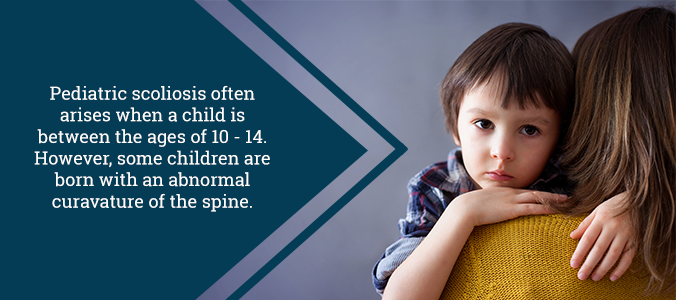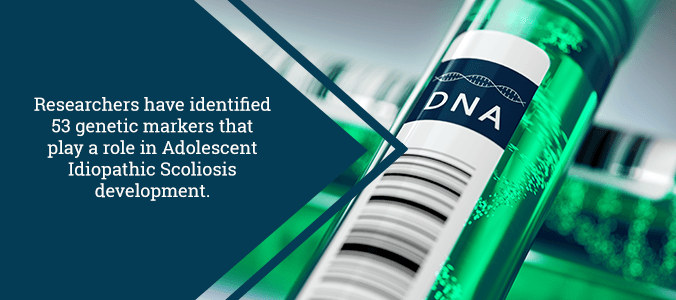Genetic Testing for Scoliosis Progression
Many people view scoliosis as a “bone” condition. But, the interaction between our brain and our muscles can also lead to scoliosis (See – neuromuscular scoliosis).
The most common sign of scoliosis – an S-curve in the spine – has made this condition seem much more bone-centric than it actually is. It has also been a part of why scoliosis presents such a challenge to health care providers all around the globe.
Most cases of pediatric scoliosis arise between the ages of 10 – 14. Females are 5 to 8 times more likely than males to need scoliosis surgery. While doctors use the term scoliosis to describe any curve that is greater than 10-degrees, severe cases can be much greater than 45-degrees.
If you have scoliosis, then your spine may seem to have a “C” or even an “S” bend when viewed from the front or the back. In some cases, the spine may rotate slightly, causing an uneven sort of appearance. As such, based upon where the curve occurs, it may also affect the angle of your pelvic tilt.
In most cases, this condition will progress. But, finding the likelihood of that progression has been hard for doctors to predict. Luckily, today’s providers know more now than ever before about how to test for scoliosis and assign treatments.

Types of Scoliosis
Your doctor may not be able to detect a specific cause for your scoliosis. If this is the case, then your condition may be deemed “idiopathic.” This is just a fancy way of saying that there is no known cause for your scoliosis. The basic types of scoliosis include:
- Idiopathic: As mentioned, this type of scoliosis has no known origin. As such, all ages can be affected by this disorder.
- Congenital: Congenital scoliosis is a rare condition, affecting only 1 in 10,000 babies. With this type, an abnormal bend in the spine is present at birth.
- Neuromuscular: Children who have certain disorders like muscular dystrophy, cerebral palsy, or Marfan’s syndrome (etc.) may develop this type of scoliosis.
- Degenerative: This form of scoliosis usually occurs after age 65, when the spine begins to break down from years of abuse or wear and tear.
Scoliosis Testing
Not surprisingly, it’s the “idiopathic” type of scoliosis that baffles doctors the most. For example, Adolescent Idiopathic Scoliosis (AIS) seems to rely on both genetic factors, as well as the unique workings of the spine.
A great number of studies also suggest that scoliosis runs in families. In fact, we see greater rates of this condition in families than we do in the general population. While no single gene has been identified as the “true” cause of scoliosis, researchers have detected 53 genetic markers that play a role in AIS development.
In brief, this means that doctors can now predict the rate of curve progression for AIS patients. Furthermore, prognostic testing is gene-based, offering more scientific and customized options for patient care. On the other hand, it’s important to note: This exam is not a screening device. Instead, the ScoliScore Test predicts the trajectory of curve progression in children who are already diagnosed with AIS.

The ScoliScore Test
Years of development, thousands of DNA test samples, and endless calculations later, researchers were able to find the specific markers for scoliosis. From there, results led to the first clinically-validated exam – the ScoliScore Test. Doctors created this test to help predict curvature in a child’s early years. (Previously, such results required years of close observation.)
The worth of such a test is astounding. It allows doctors to use a simple exam to identify patients who will progress to severe stages. This is an advancement that saves time and money, and allows for much more successful treatment of AIS cases. No more of that bulky bracing or the endless need for x-rays!
The ScoliScore Test assigns a number in order to indicate low, intermediate, or high risk for curve progression. That number is based on the child’s DNA as well as their current Cobb angle. For best results, a child must fall between the ages of 9 to 13 and have mild to moderate curvature.
This simple, pain-free test is performed by collecting the patient’s saliva and running tests. This, combined with current status, family history, and remaining growth allows your doctor to create a custom treatment plan.
Are you interested in cutting-edge treatments and diagnostics for AIS? Dr. Jason Lowenstein is an industry leading expert on scoliosis. He offers his unique set of skills for even the most complicated spinal deformity surgeries. If you (or your child) has been recommended for scoliosis treatment, then you can count on Dr. Lowenstein to resolve your condition. Trust and compassionate care are two things that you can always be sure you’re getting when you contact Dr. Lowenstein and his team of spine experts!
